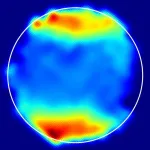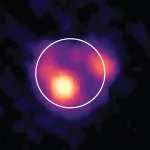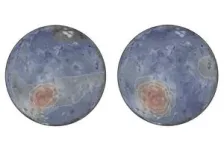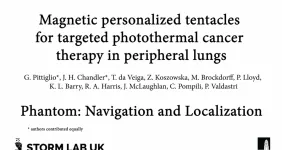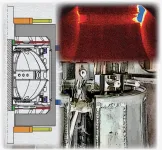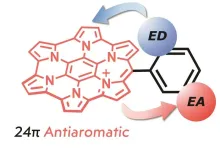(Press-News.org) With its sensitive infrared cameras and high-resolution spectrometer, the James Webb Space Telescope (JWST) is revealing new secrets of Jupiter's Galilean satellites, in particular Ganymede, the largest moon, and Io, the most volcanically active.
In two separate publications, astronomers who are part of JWST's Early Release Science program report the first detection of hydrogen peroxide on Ganymede and sulfurous fumes on Io, both the result of Jupiter's domineering influence.
"This shows that we can do incredible science with the James Webb Space Telescope on solar system objects, even if the object is really very bright, like Jupiter, but also when you look at very faint things next to Jupiter," said Imke de Pater, professor emerita of astronomy and earth and planetary science at the University of California, Berkeley. De Pater and Thierry Fouchet from the Paris Observatory are co-principal investigators for the Early Release Science solar system observation team, one of 13 teams given early access to the telescope.
Samantha Trumbo, a 51 Pegasi b postdoctoral fellow at Cornell University, led the study of Ganymede, which was published July 21 in the journal Science Advances. Using measurements captured by the near infrared spectrometer (NIRSpec) on JWST, the team detected the absorption of light by hydrogen peroxide — H2O2 — around the north and south poles of the moon, a result of charged particles around Jupiter and Ganymede impacting the ice that blankets the moon.
"JWST revealing the presence of hydrogen peroxide at Ganymede’s poles shows for the first time that charged particles funneled along Ganymede’s magnetic field are preferentially altering the surface chemistry of its polar caps," Trumbo said.
The astronomers argue that the peroxide is produced by charged particles hitting the frozen water ice around the poles and breaking the water molecules into fragments — a process called radiolysis — which then recombine to form H2O2. They suspected that radiolysis would occur primarily around the poles on Ganymede because, unlike all other moons in our solar system, it has a magnetic field that directs charged particles toward the poles.
"Just like how Earth’s magnetic field directs charged particles from the sun to the highest latitudes, causing the aurora, Ganymede’s magnetic field does the same thing to charged particles from Jupiter’s magnetosphere," she added. "Not only do these particles result in aurorae at Ganymede, as well, but they also impact the icy surface."
Trumbo and Michael Brown, professor of planetary astronomy at Caltech, where Trumbo recently received her Ph.D., had earlier studied hydrogen peroxide on Europa, another of Jupiter's four Galilean satellites. On Europa, however, the peroxide was detectable over much of the surface, perhaps, in part, because it has no magnetic field to protect the surface from the fast-moving particles zipping around Jupiter.
"This is likely a really important and widespread process," Trumbo said. "These observations of Ganymede provide a key window to understand how such water radiolysis might drive chemistry on icy bodies throughout the outer solar system, including on neighboring Europa and Callisto (the fourth Galilean moon)."
"It helps to actually understand how this so-called radiolysis works and that, indeed, it works as people expected, based on lab experiments on Earth," de Pater said.
Io's sulfurous environment
In a second paper, accepted for publication in the journal JGR: Planets, a publication of the American Geophysical Union, de Pater and her colleagues report new Webb observations of Io that show several ongoing eruptions, including a brightening at a volcanic complex called Loki Patera and an exceptionally bright eruption at Kanehekili Fluctus. Because Io is the only volcanically active moon in the solar system — Jupiter's gravitational push and pull heats it up — studies like this give planetary scientists a different perspective than can be obtained by studying volcanos on Earth.
For the first time, the researchers were able to link a volcanic eruption — at Kanehekili Fluctus — to a specific emission line, a so-called “forbidden” line, of the gas sulfur monoxide (SO).
Sulfur dioxide (SO2) is the main component of Io's atmosphere, coming from sublimation of SO2 ice, as well as ongoing volcanic eruptions, similar to the production of SO2 by volcanos on Earth. The volcanos also produce SO, which is much harder to detect than SO2. In particular, the forbidden SO emission line is very weak because SO is in such low concentrations and produced for only a short time after being excited. Moreover, the observations can only be made when Io is in Jupiter’s shadow, when it is easier to see the glowing SO gases. When Io is in Jupiter's shadow, the SO2 gas in Io’s atmosphere freezes out onto its surface, leaving only SO and newly emitted volcanic SO2 gas in the atmosphere.
"These observations with Webb show for the first time that the SO actually did come from a volcano," de Pater said.
De Pater had made previous observations of Io with the Keck Telescope in Hawaii and found low levels of the forbidden SO emission over much of the planet, but she was unable to tie SO hotspots specifically to an active volcano. She suspects that much of this SO, as well as the SO2 seen during an eclipse, is coming from so-called stealth volcanoes, which erupt gas but not dust, which would make them visible.
Twenty years ago, de Pater and her team proposed that this excited state of SO could only be produced in hot volcanic vents, and that the tenuous atmosphere allowed this state to stick around long enough — a few seconds — to emit the forbidden line. Normally, excited states that produce this emission are quickly damped out by collisions with other molecules in the atmosphere and never seen. Only in parts of the atmosphere where the gas is sparse do such excited states last long enough to emit forbidden lines. The greens and reds of Earth's auroras are produced by forbidden transitions of oxygen in the tenuous upper atmosphere.
"The link between SO and volcanoes ties in with a hypothesis we had in 2002 to explain how we could see SO emission at all," she said. "The only way we could explain this emission is if the SO is excited in the volcanic vent at a temperature of 1500 Kelvin or so, and that it comes out in this excited state, loses its photon within a few seconds, and that is the emission we see. So these observations are the first that actually show that this is the most likely mechanism of why we see that SO."
Webb will observe Io again in August with NIRSpec. The upcoming observation and the earlier one, which took place on Nov. 15, 2022, were taken when Io was in the shadow of Jupiter so that light reflected from the planet did not overwhelm the light coming from Io.
De Pater noted, too, that the brightening of Loki Patera was consistent with the observed period of eruptions at the volcano, which brighten, on average, about every 500 Earth days, with the brightening lasting for a couple of months. She determined this because it was not bright when she observed the moon with Keck in August and September 2022, nor was it bright when another astronomer observed it from April through July 2022. Only the JWST captured the event.
"The Webb observations showed that actually eruptions had started, and that it was much brighter than what we had seen in September," she said.
While De Pater is primarily focused on the Jovian system — its rings, small moons and the larger moons Ganymede and Io — she and other members of the early science team of some 80 astronomers are also using JWST to study the planetary systems of Saturn, Uranus and Neptune.
END
James Webb Space Telescope sees Jupiter moons in a new light
Hydrogen peroxide detected at Ganymede's poles; sulfur monoxide from Io's volcanos
2023-07-27
ELSE PRESS RELEASES FROM THIS DATE:
Tiny surgical robots could transform detection and treatment of cancers
2023-07-27
The ultra-soft tentacle, which measures just 2 millimetres in diameter and is controlled by magnets, can reach some of the smallest bronchial tubes and could transform the treatment of lung cancer.
It paves the way for a more accurate, tailored, and far less invasive approach to treatment and has been developed by engineers, scientists and clinicians based at the STORM Lab in Leeds.
The researchers tested the magnetic tentacle robot on the lungs of a cadaver and found that it can travel 37% deeper than the standard equipment and leads to less tissue damage.
The results ...
Fusion model hot off the wall
2023-07-27
Kyoto, Japan -- Humans may never be able to tame the Sun, but hydrogen plasma -- making up most of the Sun's interior -- can be confined in a magnetic field as part of fusion power generation: with a caveat.
The extremely high temperature plasmas, typically as high as 100 million degrees Celsius, confined in the tokamaks -- donut-shaped fusion reactors -- cause damage to the containment walls of these mega devices. Researchers inject hydrogen and inert gases near the device wall to cool the plasma by radiation and recombination, ...
Stockholm University leads Bio-LUSH for development of new sustainable bio-based fibers for a circular bioeconomy
2023-07-27
Bio-LUSH, a Horizon Europe project led by Stockholm University, extracts high-quality fibers from diverse plants, maximizing resource utilization for sustainable bio-based innovation. Supported by the EU-call Circular Bio-based Europe Joint Undertaking (CBE JU), the research project establishes a value chain for sustainable products such as textiles, food packaging and reinforced composites ready for the consumer market, thus driving plant-based solutions for a circular bioeconomy.
The four-year Bio-LUSH project, launched in May 2023, supports the establishment of a ...
Low fiber intake during pregnancy may delay development in infants’ brains
2023-07-27
Undernutrition during pregnancy is one of the factors linked to an increased risk of diseases in children as they grow older. Yet, maternal malnutrition remains a problem for women worldwide.
Animal studies have shown that a low-fiber diet during pregnancy impairs brain nerve function in offspring. Now, in the first human cohort study on the relation of maternal nutritional imbalance and infants’ brain development, researchers in Japan have investigated if the same effects can be found in humans.
“Most pregnant women in Japan consume far less dietary ...
Cannabis poisonings rise after legalization, new review concludes
2023-07-27
A new meta-analysis (an analysis of past research) published by the scientific journal Addiction has found that cannabis legalisation is associated with increased rates of cannabis poisoning. The risk of cannabis poisoning was higher among studies that focused on children.
Cannabis poisoning occurs when too much cannabis is consumed at one time. The effects of cannabis poisoning include lethargy, drowsiness, dizziness, hypertension, palpitations, tachycardia (elevated heart rate), nausea, vomiting, irritability, agitation, coma, and slowing of the central nervous system. Cannabis use in children ...
New On Our Sleeves® survey highlights top stressors as students prepare to head back to school
2023-07-27
COLUMBUS, Ohio (July 27, 2023) — Preparing to head back to school can be a time of many emotions, from excitement to nerves. But for children who found the previous school year to be challenging, it can be an especially stressful experience.
In a new national survey conducted online by The Harris Poll on behalf of The On Our Sleeves Movement for Children’s Mental Health, 71% of American parents say their children experienced challenges last school year.
The top factors identified by parents included safety concerns (37%), academic challenges (26%), bullying (24%), ongoing social challenges ...
New research method determines health impacts of heat and air quality
2023-07-27
The planet experienced the hottest day on record earlier this month and climate projections estimate the intensity of heat waves and poor air quality will increase and continue to cause severe impacts. Researchers from the University of Waterloo and Toronto Metropolitan University have refined and expanded a method of data collection to assess their health impacts.
They discovered that even moderate temperature increases, for example night-time temperatures starting at 18.4 degrees Celsius, can lead to increased hospital ...
A demonstration of substituent effects in anti-aromatic compounds
2023-07-27
Circularly conjugated compounds with 4n+2 pi-electrons are known as aromatic compounds. They are generally stable and are therefore found in our surroundings. On the other hand, anti-aromatic compounds with 4n pi-electrons have been conventionally considered unstable, and the creation of stable anti-aromatic compounds has been one of the challenging issues in organic chemistry. Several studies on the synthesis, isolation, and characterization of stable and clearly anti-aromatic compounds have been reported in recent years. In general, anti-aromatic compounds are considered to be more susceptible to substituents than aromatic compounds because of their narrower HOMO-LUMO gap. However, ...
Older women at risk for Alzheimer’s disease may benefit from yoga
2023-07-27
Kundalini yoga, a form of yoga that focuses on breathing, meditation, and mental visualization, appeared beneficial for older women who had risk factors for Alzheimer’s disease and concerns about episodes of memory decline, according to a UCLA Health study.
Researchers at UCLA Semel Institute for Neuroscience and Human Behavior, using a type of MRI that measures activity in regions and subregions of the brain, found that Kundalini yoga, which combines movement and meditation and focuses on breathing, mantra recitation and mental visualization, increased connectivity in an area of the brain that can be impacted by stress and ...
Cigarette smokers more at risk for tobacco dependence than users of smokeless tobacco or multiple tobacco products
2023-07-27
New York, NY (July 27, 2023) – Cigarette smokers have higher odds of tobacco dependence than those who vape or use a variety of types of tobacco products, according to a Mount Sinai study published in July in Nicotine & Tobacco Research.
The findings suggest that tailored tobacco cessation programs are needed for people with different tobacco use habits. The researchers identified three clear types of tobacco users: those who predominantly smoke cigarettes, those who predominantly use smokeless tobacco, and those who predominantly use a combination of cigarettes, e-cigarettes, and cigars.
This discovery is important for tailoring tobacco use reduction ...
LAST 30 PRESS RELEASES:
Making lighter work of calculating fluid and heat flow
Normalizing blood sugar can halve heart attack risk
Lowering blood sugar cuts heart attack risk in people with prediabetes
Study links genetic variants to risk of blinding eye disease in premature infants
Non-opioid ‘pain sponge’ therapy halts cartilage degeneration and relieves chronic pain
AI can pick up cultural values by mimicking how kids learn
China’s ecological redlines offer fast track to 30 x 30 global conservation goal
Invisible indoor threats: emerging household contaminants and their growing risks to human health
Adding antibody treatment to chemo boosts outcomes for children with rare cancer
Germline pathogenic variants among women without a history of breast cancer
Tanning beds triple melanoma risk, potentially causing broad DNA damage
Unique bond identified as key to viral infection speed
Indoor tanning makes youthful skin much older on a genetic level
Mouse model sheds new light on the causes and potential solutions to human GI problems linked to muscular dystrophy
The Journal of Nuclear Medicine ahead-of-print tip sheet: December 12, 2025
Smarter tools for peering into the microscopic world
Applications open for funding to conduct research in the Kinsey Institute archives
Global measure underestimates the severity of food insecurity
Child survivors of critical illness are missing out on timely follow up care
Risk-based vs annual breast cancer screening / the WISDOM randomized clinical trial
University of Toronto launches Electric Vehicle Innovation Ontario to accelerate advanced EV technologies and build Canada’s innovation advantage
Early relapse predicts poor outcomes in aggressive blood cancer
American College of Lifestyle Medicine applauds two CMS models aligned with lifestyle medicine practice and reimbursement
Clinical trial finds cannabis use not a barrier to quitting nicotine vaping
Supplemental nutrition assistance program policies and food insecurity
Switching immune cells to “night mode” could limit damage after a heart attack, study suggests
URI-based Global RIghts Project report spotlights continued troubling trends in worldwide inhumane treatment
Neutrophils are less aggressive at night, explaining why nighttime heart attacks cause less damage than daytime events
Menopausal hormone therapy may not pose breast cancer risk for women with BRCA mutations
Mobile health tool may improve quality of life for adolescent and young adult breast cancer survivors
[Press-News.org] James Webb Space Telescope sees Jupiter moons in a new lightHydrogen peroxide detected at Ganymede's poles; sulfur monoxide from Io's volcanos
